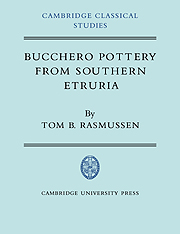Summary
It is likely that most of the decorative techniques employed on bucchero are derived ultimately from metalware. Not only many of the techniques but also some of the motives to be observed on bucchero are found also on impasto pottery. But on impasto they are employed rather at random, whereas bucchero evolves a number of distinctive decorative schemes, which in many cases are related to the shape of the pot. Decoration on early bucchero can be quite lavish, often making use of several techniques together; but some of these, such as rouletting, are discarded by the end of the seventh century, and few survive far into the sixth. Completely plain pots are normal for the sixth century and later, and are by no means unknown even in the earliest period of bucchero production.
SILVERING
Some bucchero pots seem originally to have had a silver overlay covering the entire exterior and, on open shapes, the interior as well. The evidence comes from very small fragments of silver leaf found still attached to the surface. In one instance chemical analysis has shown that the adhesive agent used is a compound of mercury (Ramage, 17f.). The total number of pots which still show these traces is very small, but this may be due to such a fragile surface having perished over the centuries. It may be significant that almost all the bucchero from the Camera degli Alari (Ramage, 39ff.) – one of the very few tomb-chambers found intact – shows evidence of silvering.
- Type
- Chapter
- Information
- Bucchero Pottery from Southern Etruria , pp. 128 - 142Publisher: Cambridge University PressPrint publication year: 1979



